Impact of Streetscape Built Environment Characteristics on Human Perceptions Using Street View Imagery and Deep Learning: A Case Study of Changbai Island, Shenyang
Abstract
1. Introduction
- (1)
- Delineate the study area and determine the sample points in ArcGIS.
- (2)
- Quantify physical street characteristics via semantic segmentation technology and extract key morphological indices, such as green visibility rate and interface continuity.
- (3)
- Obtain residents’ street perception data using the Place Pulse 2.0 dataset.
- (4)
- Explore the relationship between physical street attributes and residents’ emotional perceptions.
2. Literature Review
2.1. Theoretical Studies Related to Human Perception
2.2. Human Perception Assessment of Urban Streets
2.3. Assessment of the Physical Characteristics of Urban Streets
2.4. Methods for Acquiring Human Perceptual Features
2.5. Methods for Obtaining the Physical Spatial Characteristics of Streets
3. Materials and Methods
3.1. Study Site
3.2. Baidu Street View Image Collection
3.3. Street Space Environment Indicator Extraction
3.4. Calculating Public Visual Perception Data
3.5. Statistical Analysis
4. Results
4.1. Physical Characteristics of the Study Area
4.2. Perceptual Characterization Data Results
4.3. The Effect of the Physical Characteristics of the Built Environment of Streets on Perceived Features
4.3.1. Correlation Analysis
4.3.2. Regression Analysis
- (1)
- Multiple linear regression analysis of beauty perception
- (2)
- Multiple linear regression analysis of safety perception
- (3)
- Multiple linear regression analysis of liveliness perception
- (4)
- Multiple linear regression analysis of boredom perception
5. Discussion
5.1. Perceptual and Physical Characteristics of Urban Streets
5.2. Relationship Between Physical and Perceptual Characteristics
5.3. Optimization Strategies Proposed by the Study
5.4. Limitations of This Study
6. Conclusions
Author Contributions
Funding
Data Availability Statement
Acknowledgments
Conflicts of Interest
Appendix A
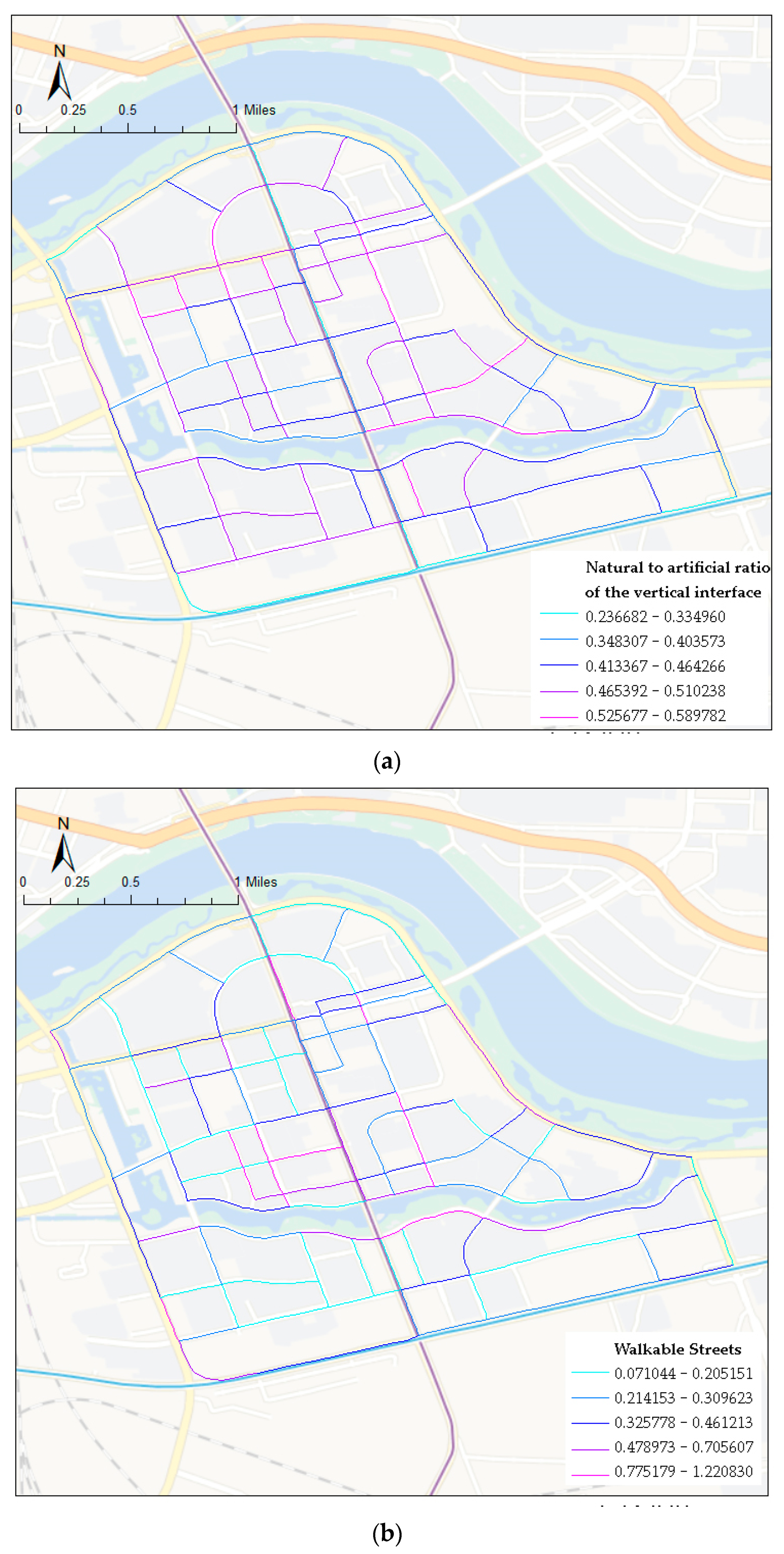

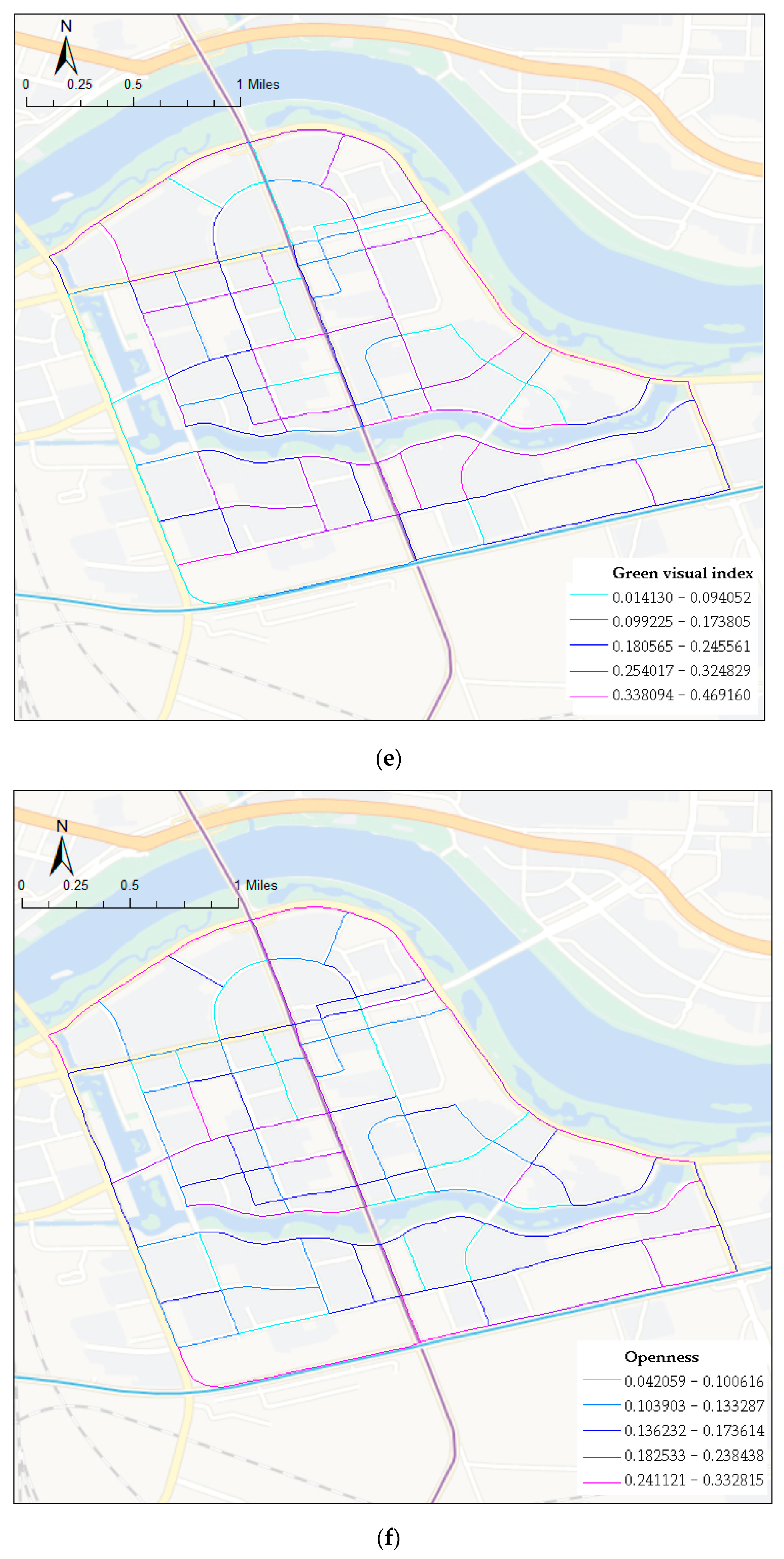

Appendix B

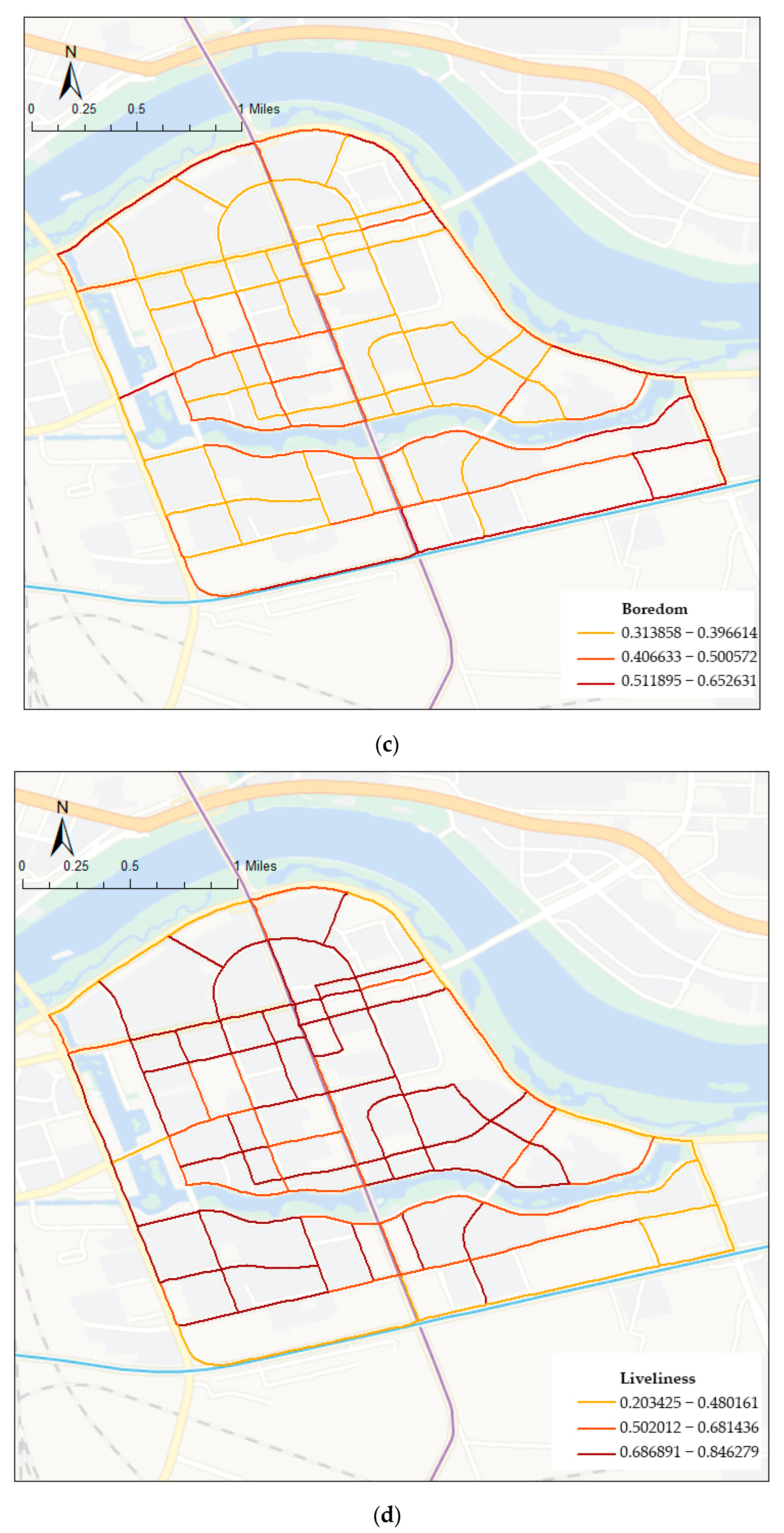
References
- Wei, J.; Yue, W.; Li, M.; Gao, J. Mapping human perception of urban landscape from street-view images: A deep-learning approach. Int. J. Appl. Earth Obs. Geoinf. 2022, 112, 102886. [Google Scholar] [CrossRef]
- Ewing, R.; Handy, S. Measuring the unmeasurable: Urban design qualities related to walkability. J. Urban Des. 2009, 14, 65–84. [Google Scholar] [CrossRef]
- Wang, R.; Liu, Y.; Lu, Y.; Zhang, J.; Liu, P.; Yao, Y.; Grekousis, G. Perceptions of built environment and health outcomes for older Chinese in Beijing: A big data approach with street view images and deep learning technique. Comput. Environ. Urban Syst. 2019, 78, 101386. [Google Scholar] [CrossRef]
- Nasar, J.L. Perception, Cognition, and Evaluation of Urban Places. Public Places Spaces 1989, 10, 31–56. [Google Scholar]
- Wood, L.; Hooper, P.; Foster, S.; Bull, F. Public green spaces and positive mental health–investigating the relationship between access, quantityand types ofparks and mental wellbeing. Health Place 2017, 48, 63–71. [Google Scholar] [CrossRef]
- Su, M.; Du, Y.K.; Liu, Q.M.; Ren, Y.J.; Kawachi, I.; Lv, J.; Li, L.M. Objective assessment of urban built environment related to physical activity—Development, reliability and validity of the China Urban Built Environment Scan Tool (CUBEST). BMC Public Health 2014, 14, 109. [Google Scholar] [CrossRef]
- Dai, L.Y.; Zheng, C.L.; Dong, Z.K.; Yao, Y.; Wang, R.F.; Zhang, X.T.; Ren, S.L.; Zhang, J.Q.; Song, X.Q.; Guan, Q.F. Analyzing the correlation between visual space and residents’ psychology in Wuhan, China using street-view images and deep-learning technique. City Environ. Interact. 2021, 11, 100069. [Google Scholar] [CrossRef]
- Wang, X.X.; Shi, R.T.; Zhou, Y. Dynamics of urban sprawl and sustainable development in China. Socio-Econ. Plan. Sci. 2020, 70, 100736. [Google Scholar] [CrossRef]
- Chen, C.; Li, H.; Luo, W.; Xie, J.; Yao, J.; Wu, L.; Xia, Y. Predicting the effect of street environment on residents’ mood states in large urban areas using machine learning and street view images. Sci. Total Environ. 2022, 816, 151605. [Google Scholar] [CrossRef]
- Li, X.Y.; Mou, Y.C.; Wang, H.Y.; Yin, C.H.; He, Q.S. How does polycentric urban form affect urban commuting? quantitative measurement using geographical big data of 100 cities in china. Sustainability 2018, 10, 4566. [Google Scholar] [CrossRef]
- Musse, M.A.; Barona, D.A.; Santana Rodriguez, L.M. Urban environmental quality assessment using remote sensing and census data. Int. J. Appl. Earth Obs. Geoinf. 2018, 71, 95–108. [Google Scholar] [CrossRef]
- Kaklauskas, A.; Bardauskiene, D.; Cerkauskiene, R.; Ubarte, I.; Raslanas, S.; Radvile, E.; Kaklauskaite, U.; Kaklauskiene, L. Emotions analysis in public spaces for urban planning. Land Use Policy 2021, 107, 105458. [Google Scholar] [CrossRef]
- Barahmand, U.; Shahbazi, H.; Shahbazi, Z. Implications ofperceived physical and social aspects ofthe environment for self-reported physical and mental health. Int. J. Environ. Health Res. 2013, 23, 31–45. [Google Scholar] [CrossRef] [PubMed]
- Li, X.; Zhang, C.; Li, W.; Ricard, R.; Meng, Q.; Zhang, W. Assessing street-level urban greenery using Google Street View and a modified green view index. Urban For. Urban Green. 2015, 14, 675–685. [Google Scholar] [CrossRef]
- Dubey, A.; Naik, N.; Parikh, D.; Raskar, R.; Hidalgo, C.A. Deep Learning the City: Quantifying Urban Perception at a Global Scale. In Proceedings of the European Conference on Computer Vision, Amsterdam, The Netherlands, 11–14 October 2016. [Google Scholar]
- Karndacharuk, A.; Wilson, D.J.; Dunn, R. A review of the evolution of shared (street) space concepts in urban environments. Transp. Rev. 2014, 34, 190–220. [Google Scholar] [CrossRef]
- Liu, M.; Han, L.; Xiong, S.; Qing, L.; Ji, H.; Peng, Y. Large-scale street space quality evaluation based on deep learning over street view image. In Proceedings of the International Conference on Image and Graphics, Beijing, China, 23–25 August 2019. [Google Scholar]
- Zhu, D.; Wang, N.; Wu, L.; Liu, Y. Street as a big geo-data assembly and analysis unit in urban studies: A case study using Beijing taxi data. Appl. Geogr. 2017, 86, 152–164. [Google Scholar] [CrossRef]
- Xing, H.; Meng, Y. Measuring urban landscapes for urban function classification using spatial metrics. Ecol. Indic. 2020, 108, 105722. [Google Scholar] [CrossRef]
- Ma, F.; Ren, F.; Yuen, K.F.; Guo, Y.; Zhao, C.; Guo, D. The Spatial Coupling Effect between Urban Public Transport and Commercial Complexes: A Network Centrality Perspective. Sustain. Cities Soc. 2019, 50, 101645. [Google Scholar] [CrossRef]
- Galea, S.; Ahern, J.; Rudenstine, S.; Wallace, Z.; Vlahov, D. Urban built environment and depression: A multilevel analysis. J. Epidemiol. Community Health 2005, 59, 822–827. [Google Scholar] [CrossRef]
- Carmona, M.; Gabrieli, T.; Hickman, R.; Laopoulou, T.; Livingstone, N. Street appeal: The value of street improvements. Prog. Plan. 2018, 126, 1–51. [Google Scholar] [CrossRef]
- Lei, Y.L.; Zhou, H.T.; Xue, L.; Yuan, L.B.; Liu, Y.G.; Wang, M.; Wang, C. Evaluating and comparing human perceptions of streets in two megacities by integrating street-view images, deep learning, and space syntax. Buildings 2024, 14, 1847. [Google Scholar] [CrossRef]
- Han, X.; Wang, L.; He, J.; Jung, T. Restorative perception of urban streets: Interpretation using deep learning and MGWR models. Front. Public Health 2023, 11, 1141630. [Google Scholar] [CrossRef]
- Jiang, Y.; Han, Y.; Liu, M.; Ye, Y. Street vitality and built environment features: A data-informed approach from fourteen Chinese cities. Sustain. Cities Soc. 2022, 79, 103724. [Google Scholar] [CrossRef]
- Moore, T.H.M.; Kesten, J.M.; López-López, J.A.; Ijaz, S.; McAleenan, A.; Richards, A.; Gray, S.; Savovic, J.; Audrey, S. The effects of changes to the built environment on the mental health and well-being of adults: Systematic review. Health Place 2018, 53, 237–257. [Google Scholar] [CrossRef]
- Luo, S.; Shang, W.; Yan, Z.; Bi, S. Research on factors influencing the style of Chinese historic districts based on the mask R-CNN deep learning model. Buildings 2024, 14, 420. [Google Scholar] [CrossRef]
- Ma, D.F.; Zhang, S.J.; Xiao, T.Q.; Shui, T.T. Aspects of new and old urban parks most valued by residents on social media: A case study in Hefei. Sustainability 2023, 15, 13771. [Google Scholar] [CrossRef]
- Meng, Y.M.; Li, Q.Y.; Yu, Y.Q.; Yue, D.; Gan, M.Q.; Wang, S.Y.; Niu, J.N.; Fukuda, H. Research on campus space features and visual quality based on street view images: A case study on the Chongshan Campus of Liaoning University. Buildings 2023, 13, 51332. [Google Scholar] [CrossRef]
- Kaplan, R.; Kaplan, S. The Experience of Nature: A Psychological Perspective; Cambridge University Press: Cambridge, UK, 1989. [Google Scholar]
- Lynch, K. The Image of the City; MIT Press: Cambridge, MA, USA, 1960; Volume 11. [Google Scholar]
- Porzi, L.; Rota Bul`o, S.; Lepri, B.; Ricci, E. Predicting and understanding urban perception with convolutional neural networks. In Proceedings of the 23rd ACM International Conference on Multimedia, Brisbane, Australia, 26–30 October 2015. [Google Scholar]
- Tuan, Y.F. Space and Place: The Perspective of Experience; University of Minnesota Press: Minneapolis, MN, USA, 1977. [Google Scholar]
- Ulrich, R. Aesthetic and Affective Response to Natural Environment; Plenum Press: New York, NY, USA, 1983; Volume 6, pp. 85–125. [Google Scholar]
- Ulrich, R. Stress recovery during exposure to natural and urban environments. J. Environ. Psychol. 1991, 11, 201–230. [Google Scholar] [CrossRef]
- Kaplan, S. The restorative benefits of nature: Toward an integrative framework. J. Environ. Psychol. Green Psychol. 1995, 15, 169–182. [Google Scholar] [CrossRef]
- Rui, J.; Li, X. Decoding vibrant neighborhoods: Disparities between formal neighborhoods and urban villages in eye-level perceptions and physical environment. Sustain. Cities Soc. 2024, 101, 105122. [Google Scholar] [CrossRef]
- Sayers, J.M.; Cleary, M.; Hunt, G.E.; Burmeister, O.K. Service and infrastructure needs to support recovery programmes for Indigenous community mental health consumers. Int. J. Ment. Health Nurs. 2017, 26, 142–150. [Google Scholar] [CrossRef] [PubMed]
- Silva, M.G.E.; Remoaldo, P.; Peluso, M.L. Human values and tourism perception: A new approach in residents’ perceptions. Curr. Issues Tour. 2024, 28, 353–358. [Google Scholar] [CrossRef]
- Cresswell, T. Place: An Introduction, 2nd ed.; Wiley: Chichester, UK, 2014; pp. 165–190. [Google Scholar]
- Jeon, J.Y.; Jo, H.I. Effects of audio-visual interactions on soundscape and landscape perception and their influence on satisfaction with the urban environment. Build. Environ. 2020, 169, 106544. [Google Scholar] [CrossRef]
- Farias, J.C.; Lopes, A.D.; Mota, J.; Santos, M.P.; Ribeiro, J.C.; Hallal, P.C. Perception of the social and built environment and physical activity among Northeastern Brazil adolescents. Prev. Med. 2011, 52, 114–119. [Google Scholar]
- Jack, E.; McCormack, G.R. The associations between objectively-determined and self-reported urban form characteristics and neighborhood-based walking in adults. Int. J. Behav. Nutr. Phys. Act. 2014, 11, 71. [Google Scholar] [CrossRef]
- Polat, A.T.; Akay, A. Relationships between the visual preferences of urban recreation area users and various landscape design elements. Urban For. Urban Green. 2015, 14, 573–582. [Google Scholar] [CrossRef]
- Wu, Z.F.; Ren, Y. The influence of greenspace characteristics and building configuration on depression in the elderly. Build. Environ. 2021, 188, 107477. [Google Scholar]
- Gascon, M.; Sánchez-Benavides, G.; Dadvand, P.; Martínez, D.; Gramunt, N.; Gotsens, X.; Cirach, M.; Vert, C.; Molinuevo, J.L.; Crous-Bou, M.; et al. Long-term exposure to residential green and blue spaces and anxiety and depression in adults: A cross-sectional study. Environ. Res. 2018, 162, 231–239. [Google Scholar] [CrossRef]
- Song, L.Y.; Zhang, A.; Hu, Z.W. Greenspace exposure is conducive to the resilience of public sentiment during the COVID-19. Health Place 2023, 83, 103096. [Google Scholar] [CrossRef]
- Sun, D.; Li, Q.Y.; Gao, W.J.; Huang, G.H.; Tang, N.; Lyu, M.; Yu, Y.Q. On the relation between visual quality and landscape characteristics: A case study application to the waterfront linear parks in Shenyang, China. Environ. Res. Commun. 2021, 3, 115013. [Google Scholar] [CrossRef]
- Nasar, J.L. Urban design aesthetics: The evaluative qualities of building exteriors. Environ. Behav. 1994, 26, 377. [Google Scholar] [CrossRef]
- Huang, G.H.; Yu, Y.Q.; Lyu, M.; Sun, D.; Zeng, Q.; Bart, D. Using google street view panoramas to investigate the influence of urban coastal street environment on visual walkability. Environ. Res. Commun. 2023, 5, 065017. [Google Scholar] [CrossRef]
- Kawshalya, L.W.G.; Weerasinghe, U.G.D.; Chandrasekara, D.P. The impact of visual complexity on perceived safety and comfort of the users: A study on urban streetscape of Sri Lanka. PLoS ONE 2022, 17, e0272074. [Google Scholar] [CrossRef] [PubMed]
- Dillon, R. Designing urban space for psychological comfort: The Kentish Town Road project. J. Public Ment. Health 2005, 4, 10–20. [Google Scholar] [CrossRef]
- Park, Y.; Garcia, M. Pedestrian safety perception and urban street settings. Int. J. Sustain. Transp. 2020, 14, 860–871. [Google Scholar] [CrossRef]
- Liu, M.; Jiang, Y.; He, J.L. Quantitative evaluation on street vitality: A case study of Zhoujiadu Community in Shanghai. Sustainability 2021, 13, 3027. [Google Scholar] [CrossRef]
- Larkin, A.; Gu, X.; Chen, L.Z.; Hystad, P. Predicting perceptions of the built environment using GIS, satellite and street view image approaches. Landsc. Urban Plan. 2021, 216, 104257. [Google Scholar] [CrossRef]
- Zhang, J.X.; Yu, Z.L.; Li, Y.Q.; Wang, X.Q. Uncovering Bias in Objective Mapping and Subjective Perception of Urban Building Functionality: A Machine Learning Approach to Urban Spatial Perception. Land 2023, 12, 1322. [Google Scholar] [CrossRef]
- Lee, J.; Kim, D.; Park, J. A machine learning and computer vision study of the environmental characteristics of streetscapes that affect pedestrian satisfaction. Sustainability 2022, 14, 5730. [Google Scholar] [CrossRef]
- Ma, X.Y.; Ma, C.Y.; Wu, C.; Xi, Y.L.; Yang, R.F.; Peng, N.Y.Z.; Zhang, C.; Ren, F. Measuring human perceptions of streetscapes to better inform urban renewal: A perspective of scene semantic parsing. Cities 2021, 110, 103086. [Google Scholar] [CrossRef]
- Li, X.J.; Ratti, C.; Seiferling, I. Quantifying the shade provision of street trees in urban landscape: A case study in Boston, USA, using Google Street View. Landsc. Urban Plan. 2018, 169, 81–91. [Google Scholar] [CrossRef]
- Lu, Y. Using Google Street View to investigate the association between street greenery and physical activity. Landsc. Urban Plan. 2019, 191, 103435. [Google Scholar] [CrossRef]
- Harvey, C.; Aultman-Hall, L.; Hurley, S.E.; Troy, A. Effects of skeletal streetscape design on perceived safety. Landsc. Urban Plan. 2015, 142, 18–28. [Google Scholar] [CrossRef]
- Li, X.J.; Cai, B.; Ratti, C. Using Street-level Images and Deep Learning for Urban Landscape Studies. Landsc. Archit. Front. 2018, 6, 20. [Google Scholar] [CrossRef]
- Zhou, H.; He, S.; Cai, Y.; Wang, M.; Su, S. Social inequalities in neighborhood visual walk ability: Using street view imagery and deep learning technologies to facilitate healthy city planning. Sustain. Cities Soc. 2019, 50, 101605. [Google Scholar] [CrossRef]
- Wu, B.; Yu, B.; Shu, S.; Liang, H.; Zhao, Y.; Wu, J. Mapping fine-scale visual quality distribution inside urban streets using mobile LiDAR data. Build. Environ. 2021, 206, 108323. [Google Scholar] [CrossRef]
- Orzechowska-Szajda, I. Classification model ofurban riverside landscape using the oder river as an example. Pol. J. Environ. Stud. 2019, 29, 205–215. [Google Scholar] [CrossRef]
- Wang, L.; Han, X.; He, J.; Jung, T. Measuring residents’ perceptions of city streets to inform better street planning through deep learning and space syntax. ISPRS J. Photogramm. Remote Sens. 2022, 190, 215–230. [Google Scholar] [CrossRef]
- Tang, Y.W.; Zhang, J.X.; Liu, R.J.; Li, Y.Q. Exploring the impact of built environment attributes on social followings using social media data and deep learning. ISPRS Int. J. Geo-Inf. 2022, 11, 325. [Google Scholar] [CrossRef]
- Ames, D.L. The new urbanism: Toward an architecture of community. J. Urban Aff. 2002, 24, 118–122. [Google Scholar]
- Miller, B. In place out of place: Geography, ideology, and transgression. Ann. Assoc. Am. Geogr. 1998, 88, 737–739. [Google Scholar]
- Montello, D.R.; Goodchild, M.F.; Gottsegen, J.; Fohl, P. Where’s downtown?: Behavioral methods for determining referents of vague spatial queries. Spat. Cogn. Comput. 2003, 3, 185–204. [Google Scholar]
- Santosa, H.; Ernawati, J.; Wulandari, L.D. Visual quality evaluation of urban commercial streetscape for the development of landscape visual planning system in provincial street corridors in Malang, Indonesia. IOP Conf. Ser. Earth Environ. Sci. 2018, 126, 012202. [Google Scholar] [CrossRef]
- Zhang, F.; Zhou, B.L.; Liu, L.; Liu, Y.; Fung, H.H.; Lin, H.; Ratti, C. Measuring human perceptions of a large-scale urban region using machine learning. Landsc. Urban Plan. 2018, 180, 148–160. [Google Scholar] [CrossRef]
- Kacha, L.; Matsumoto, N.; Mansouri, A. Electrophysiological evaluation of perceived complexity in streetscapes. J. Asian Archit. Build. Eng. 2015, 14, 585–592. [Google Scholar] [CrossRef]
- Sun, D.; Zhou, F.J.; Lin, J.J.; Yang, Q.R.; Lyu, M. A study on landscape feature and emotional perception evaluation of waterfront greenway. Environ. Res. Commun. 2024, 6, 095023. [Google Scholar] [CrossRef]
- Yao, Y.; Liang, Z.T.; Yuan, Z.H.; Liu, P.H.; Bie, Y.P.; Zhang, J.B.; Wang, R.Y.; Wang, J.L.; Guan, Q.F. A human-machine adversarial scoring framework for urban perception assessment using street-view images. Int. J. Geogr. Inf. Sci. 2019, 33, 2363–2384. [Google Scholar] [CrossRef]
- Mouratidis, K. Urban planning and quality of life: A review of pathways linking the built environment to subjective well-being. Cities 2021, 115, 103229. [Google Scholar] [CrossRef]
- Wang, R.; Ren, S.; Zhang, J.; Yao, Y.; Wang, Y.; Guan, Q. A comparison of two deep-learning-based urban perception models: Which one is better? Comput. Urban Sci. 2021, 1, 3. [Google Scholar] [CrossRef]
- Tang, L.; Ding, W.W. Linking the signs on street façades to the characteristics of street space. Archit. J. 2015, 2, 18–22. [Google Scholar]
- Ewing, R.; Cervero, R. Travel and the built environment: A synthesis (with discussion). Transp. Res. Rec. 2001, 1780, 87–114. [Google Scholar] [CrossRef]
- Zhao, J.W.; Luo, P.J.; Wang, R.H.; Cai, Y.L. Correlations between aesthetic preferences ofriver and landscape characters. J. Environ. Eng. Landsc. Manag. 2013, 21, 123–132. [Google Scholar] [CrossRef]
- Ye, Y.; Zhang, Z.X.; Zhang, X.H.; Zeng, W. Human-scale quality on streets: A large-scale and efficient analytical approach based on street view images and new urban analytical tools. Urban Plan. Int. 2019, 34, 18–27. [Google Scholar] [CrossRef]
- Liu, Y.; Liu, X.; Gao, S.; Gong, L.; Kang, C.G.; Zhi, Y.; Chi, G.H.; Shi, L. Social sensing: A new approach to understanding our socioeconomic environments. Ann. Assoc. Am. Geogr. 2015, 105, 512–530. [Google Scholar] [CrossRef]
- Lyu, M.; Meng, Y.M.; Gao, W.J.; Yu, Y.Q.; Ji, X.; Li, Q.Y.; Huang, G.H.; Sun, D. Measuring the perceptual features of coastal streets: A case study in Qingdao, China. Environ. Res. Commun. 2022, 4, 115002. [Google Scholar] [CrossRef]
- Gong, F.Y.; Zeng, Z.C.; Zhang, F.; Li, X.J.; Ng, E.; Norford, L.K. Mapping sky, tree, and building view factors of street canyons in a high-density urban environment. Build. Environ. 2018, 134, 155–167. [Google Scholar] [CrossRef]
- Helbich, M.; Yao, Y.; Liu, Y.; Zhang, J.B.; Liu, P.H.; Wang, R.Y. Using deep learning to examine street view green and blue spaces and their associations with geriatric depression in Beijing, China. Environ. Int. 2019, 126, 107–117. [Google Scholar] [CrossRef]
- Meng, Y.M.; Shi, J.X.; Lyu, M.; Sun, D.; Fukuda, H. Research into the Influence Mechanisms of Visual-Comfort and Landscape Indicators of Urban Green Spaces. Land 2024, 13, 1688. [Google Scholar] [CrossRef]
- Sun, D.; Ji, X.; Gao, W.J.; Zhou, F.J.; Yu, Y.Q.; Meng, Y.M.; Yang, M.Q.; Lin, J.J.; Lyu, M. The Relation between Green Visual Index and Visual Comfort in Qingdao Coastal Streets. Buildings 2023, 13, 457. [Google Scholar] [CrossRef]
- Yao, Y.; Wang, J.L.; Hong, Y.; Qian, C.; Guan, Q.F.; Liang, X.; Dai, L.Y.; Zhang, J.B. Discovering the homogeneous geographic domain of human perceptions from street view images. Landsc. Urban Plan. 2021, 212, 104125. [Google Scholar] [CrossRef]
- Sun, D.; Ji, X.; Lyu, M.; Fu, Y.; Gao, W.J. Evaluation and diagnosis for the pedestrian quality of service in urban riverfront streets. J. Clean. Prod. 2024, 452, 142090. [Google Scholar] [CrossRef]
- Lyu, M.; Lin, J.J.; Zhou, F.J.; Niu, J.N.; Sun, D.; Meng, Y.M.; Ji, X. A method for evaluating the visual quality of wetland park landscapes: A case study of qianlu lake wetland park in Wuping, China. Environ. Res. Commun. 2024, 6, 105024. [Google Scholar] [CrossRef]
- Kido, D.; Fukuda, T.; Yabuki, N. Assessing future landscapes using enhanced mixed reality with semantic segmentation by deep learning. Adv. Eng. Inform. 2021, 48, 101281. [Google Scholar] [CrossRef]
- Tang, J.X.; Long, Y. Measuring visual quality of street space and its temporal variation: Methodology and its application in the Hutong area in Beijing. Landsc. Urban Plan. 2019, 191, 103436. [Google Scholar] [CrossRef]
- Shen, Q.; Zeng, W.; Ye, Y.; Arisona, S.M.; Schubiger, S.; Burkhard, R.; Qu, H. StreetVizor: Visual Exploration of Human-Scale Urban Forms Based on Street Views. In Proceedings of the IEEE Transactions on Visualization and Computer Graphics, Phoenix, AZ, USA, 1–6 October 2017. [Google Scholar]
- Zhang, Y.L.; Dong, R.C. Iimpacts of street-visible greenery on housing prices: Evidence from a hedonic price model and a massive street view image dataset in Beijing. ISPRS Int. J. Geo-Inf. 2018, 7, 104. [Google Scholar] [CrossRef]
- He, J.L.Y.; Zhang, J.B.; Yao, Y.; Li, X. Extracting human perceptions from street view images for better assessing urban renewal potential. Cities 2023, 134, 104189. [Google Scholar] [CrossRef]
- Li, Y.Q.; Yabuki, N.; Fukuda, T. Measuring visual walkability perception using panoramic street view images, virtual reality, and deep learning. Sustain. Cities Soc. 2022, 86, 104140. [Google Scholar] [CrossRef]
- Li, Y.Q.; Yabuki, N.; Fukuda, T.; Zhang, J.X. A big data evaluation of urban street walkability using deep learning and environmental sensors a case study around Osaka University Suita campus. In Proceedings of the International Conference on Education and Research in Computer Aided Architectural Design in Europe, Berlin, Germany, 6 November 2024. [Google Scholar]
- Li, X.; Zhang, C.R.; Li, W.D.; Kuzovkina, Y.A.; Weiner, D. Who lives in greener neighborhoods? The distribution of street greenery and its association with residents’ socioeconomic conditions in Hartford, Connecticut, USA. Urban For. Urban Green. 2015, 14, 751–759. [Google Scholar] [CrossRef]
- Rahman, A.K.M.M.; Zaber, M.; Cheng, Q.W.; Nayem, A.B.S.; Sarker, A.; Paul, O.; Shibasaki, R. Applying State-of-the-Art Deep-Learning Methods to Classify Urban Cities of the Developing World. Sensors 2021, 21, 7469. [Google Scholar] [CrossRef]
- Chen, Y.X.; Zhang, Q.L.; Deng, Z.; Fan, X.R.; Xu, Z.M.; Kang, X.D.; Pan, K.L.; Guo, Z.H. Research on green view index of urban roads based on street view image recognition: A case study of changsha downtown areas. Sustainability 2022, 14, 16063. [Google Scholar] [CrossRef]
- Meng, Y.M.; Sun, D.; Lyu, M.; Niu, J.N.; Fukuda, H. Measuring human perception of residential built environment through street view image and deep learning. Environ. Res. Commun. 2024, 6, 055020. [Google Scholar] [CrossRef]
- Wu, C.; Peng, N.; Ma, X.; Li, S.; Rao, J. Assessing multiscale visual appearance characteristics of neighbourhoods using geographically weighted principal component analysis in Shenzhen, China. Comput. Environ. Urban Syst. 2020, 84, 101547. [Google Scholar] [CrossRef]
- Yang, J.Y.; Li, X.M.; Du, J.; Cheng, C.H. Exploring the relationship between urban street spatial patterns and street vitality: A case study of Guiyang, China. Int. J. Environ. Res. Public Health 2023, 20, 1646. [Google Scholar] [CrossRef] [PubMed]
- Taylor, N. The aesthetic experience of traffic in the modern city. Urban Stud. 2003, 40, 1609–1625. [Google Scholar] [CrossRef]
- Wong, M.S.; Nichol, J.; Ng, E. A study of the “wall effect” caused by proliferation of high-rise buildings using GIS techniques. Landsc. Urban Plan 2011, 102, 245–253. [Google Scholar] [CrossRef]
- Fleming, C.M.; Manning, M.; Ambrey, C.L. Crime, greenspace and life satisfaction: An evaluation of the New Zealand experience. Landsc. Urban Plan. 2016, 149, 1–10. [Google Scholar] [CrossRef]
- Zhang, Y.; Van den Berg, A.E.; Van Dijk, T.; Weitkamp, G. Quality over quantity: Contribution of urban green space to neighborhood satisfaction. Int. J. Environ. Res. Public Health 2017, 14, 535. [Google Scholar] [CrossRef]
- Vries, S.D.; Verheij, R.A.; Groenewegen, P.P.; Spreeuwenberg, P. Natural environments: Healthy environments? An exploratory analysis of the relationship between greenspace and health. Environ. Plan. A Econ. Space 2003, 35, 1717–1731. [Google Scholar] [CrossRef]
- Wang, R.; Lu, Y.; Zhang, J.; Liu, P.; Yao, Y.; Liu, Y. The relationship between visual enclosure for neighbourhood street walkability and elders’ mental health in China. J. Transp. Health 2019, 13, 90–102. [Google Scholar] [CrossRef]
- Wolf, K.L. Business district streetscapes, trees, and consumer response. J. For. 2005, 103, 396–400. [Google Scholar] [CrossRef]
- Duan, J.P.; Liao, J.J.; Liu, J.; Gao, X.X.; Shang, A.L.; Huang, Z.H. Evaluating the spatial quality of urban living streets: A case study of Hengyang city in central south China. Sustainability 2023, 15, 10623. [Google Scholar] [CrossRef]
- Hamim, O.F.; Ukkusuri, S.V. Towards safer streets: A framework for unveiling pedestrians’ perceived road safety using street view imagery. Accid. Anal. Prev. 2024, 195, 107400. [Google Scholar] [CrossRef] [PubMed]
- Nordbø, E.C.A.; Nordh, H.; Raanaas, R.K.; Aamodt, G. GIS-derived measures of the built environment determinants of mental health and activity participation in childhood and adolescence: A systematic review. Landsc. Urban Plan. 2018, 177, 19–37. [Google Scholar] [CrossRef]
- Ji, Q.; Yin, M.; Li, Y.; Zhou, X. Exploring the influence path of high-rise residential environment on the mental health of the elderly. Sustain. Cities Soc. 2023, 98, 104808. [Google Scholar] [CrossRef]
- Farahani, M.; Razavi-Termeh, S.V.; Sadeghi-Niaraki, A.; Choi, S.M. A hybridization of spatial modeling and deep learning for people’s visual perception of urban landscapes. Sustainability 2023, 15, 10403. [Google Scholar] [CrossRef]
- Jacobs, J. The Death and Life of Great American Cities; Vintage: New York, NY, USA, 1992. [Google Scholar]
- Xu, L.; Jiang, W.; Chen, Z. Study on perceived safety in public spaces: Take perception of stree view in shanghai as an example research on the sense of security in public space. Landsc. Archit. 2018, 25, 23–29. [Google Scholar]
- Si, R.; Lin, Y.; Xiao, Z.; Ye, Y. Spatio-temporal analysis of built environment and street vitality relationship based on street-level imagery: A case study of Futian District, Shenzhen. Sci. Geogr. Sin. 2021, 41, 1536–1545. [Google Scholar]
- Wang, L.; Zhou, Y.; Wang, F.; Ding, L.; Love, P.E.; Li, S. The influence of the built environment on people’s mental health: An empirical classification of causal factors. Sustain. Cities Soc. 2021, 74, 103185. [Google Scholar] [CrossRef]
- Li, Y.C.; Peng, L.; Wu, C.W.; Zhang, J.Z. Street view imagery (SVI) in the built environment: A theoretical and systematic review. Buildings 2022, 12, 1167. [Google Scholar] [CrossRef]
- Rapoport, A. The Meaning of the Built Environment: A Nonverbal Communication Approach; University of Arizona Press: Tucson, AZ, USA, 1990. [Google Scholar]
- Gehl, J. Cities for People; Island Press: Washington, DC, USA, 2010. [Google Scholar]
- Zhang, F.; Salazar-Miranda, A.; Duarte, F.; Vale, L.; Hack, G.; Chen, M. Urban visual intelligence: Studying cities with artificial intelligence and street-level imagery. J. Plan. Lit. 2024, 39, 453. [Google Scholar] [CrossRef]
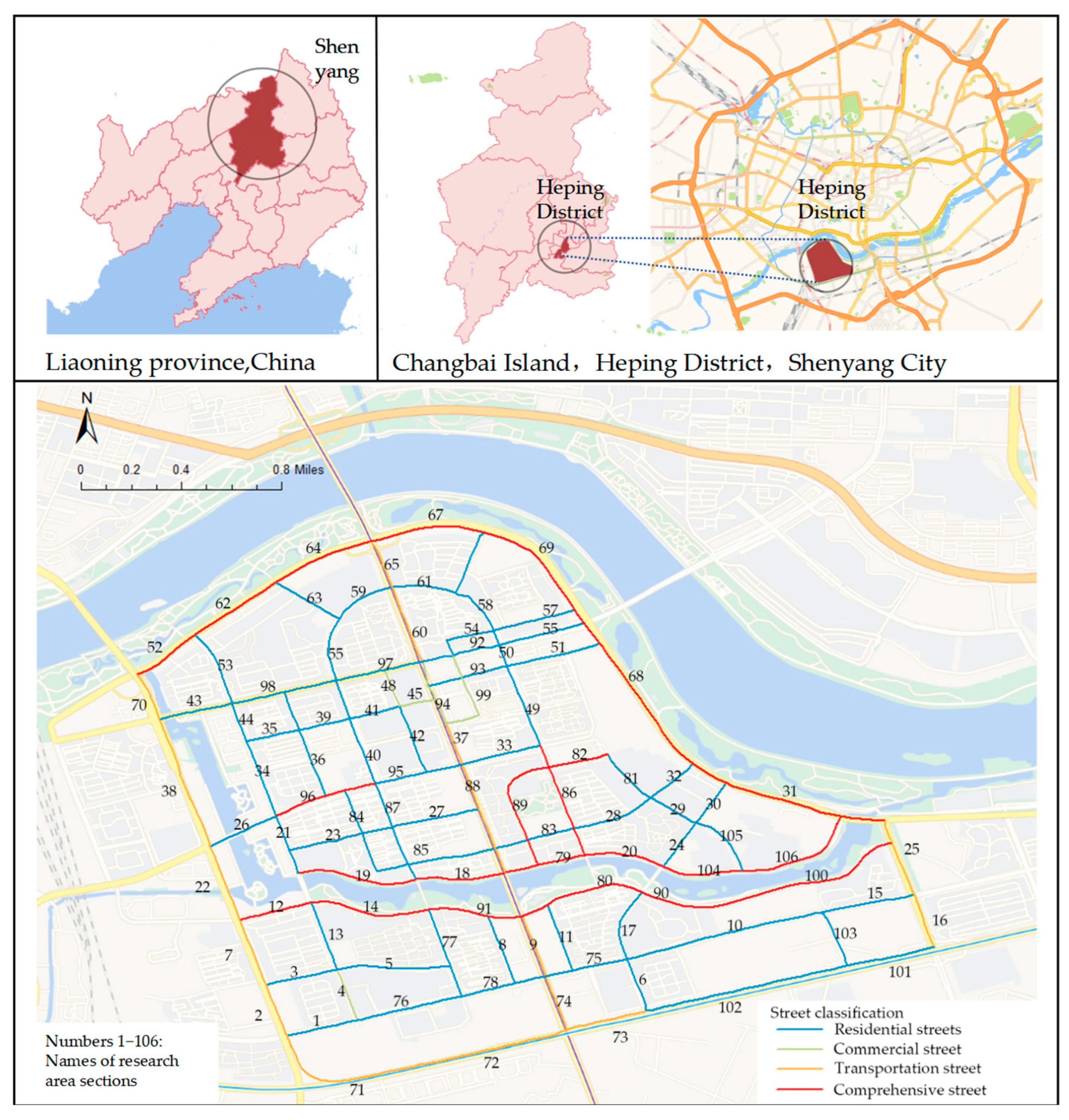

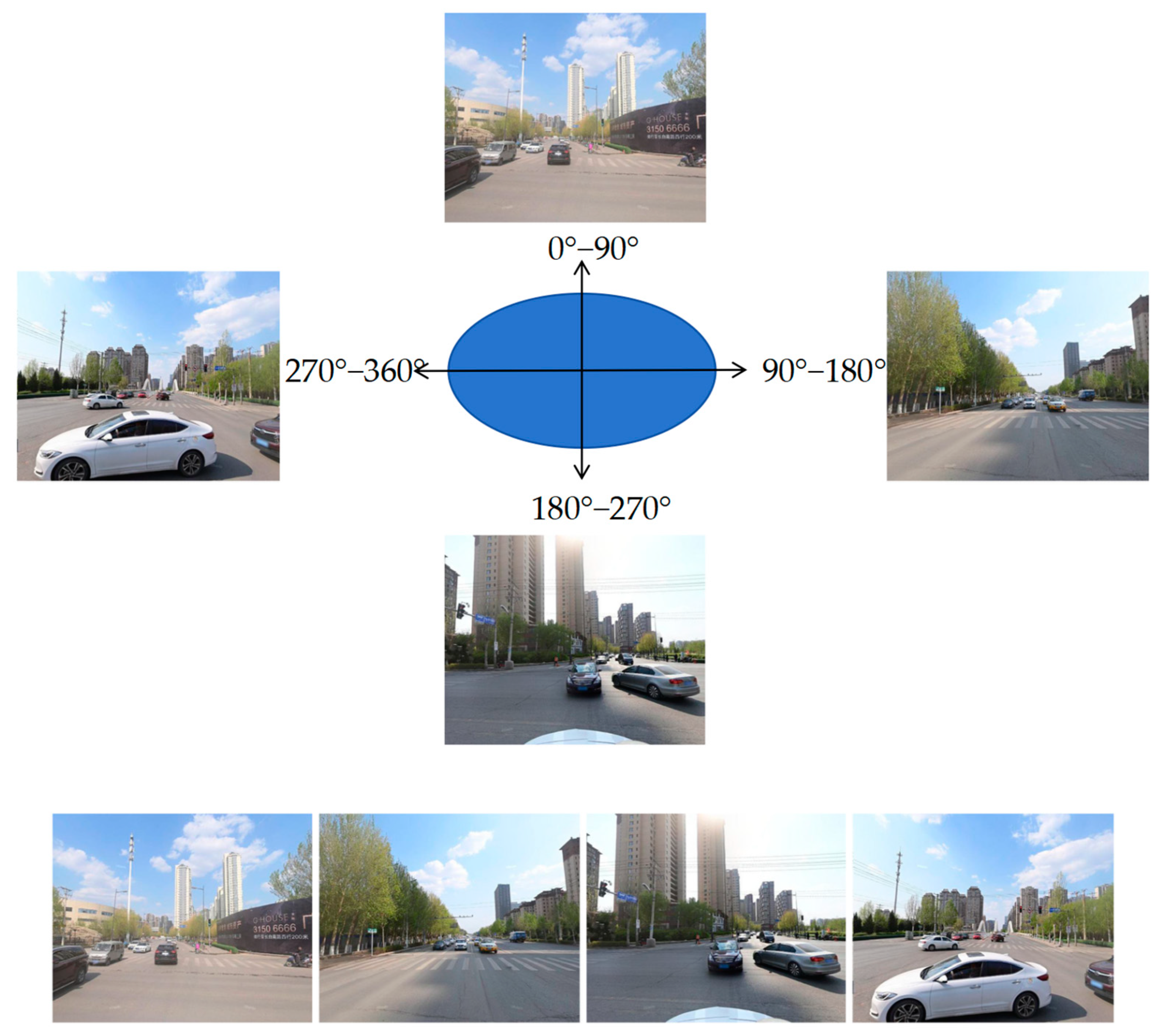
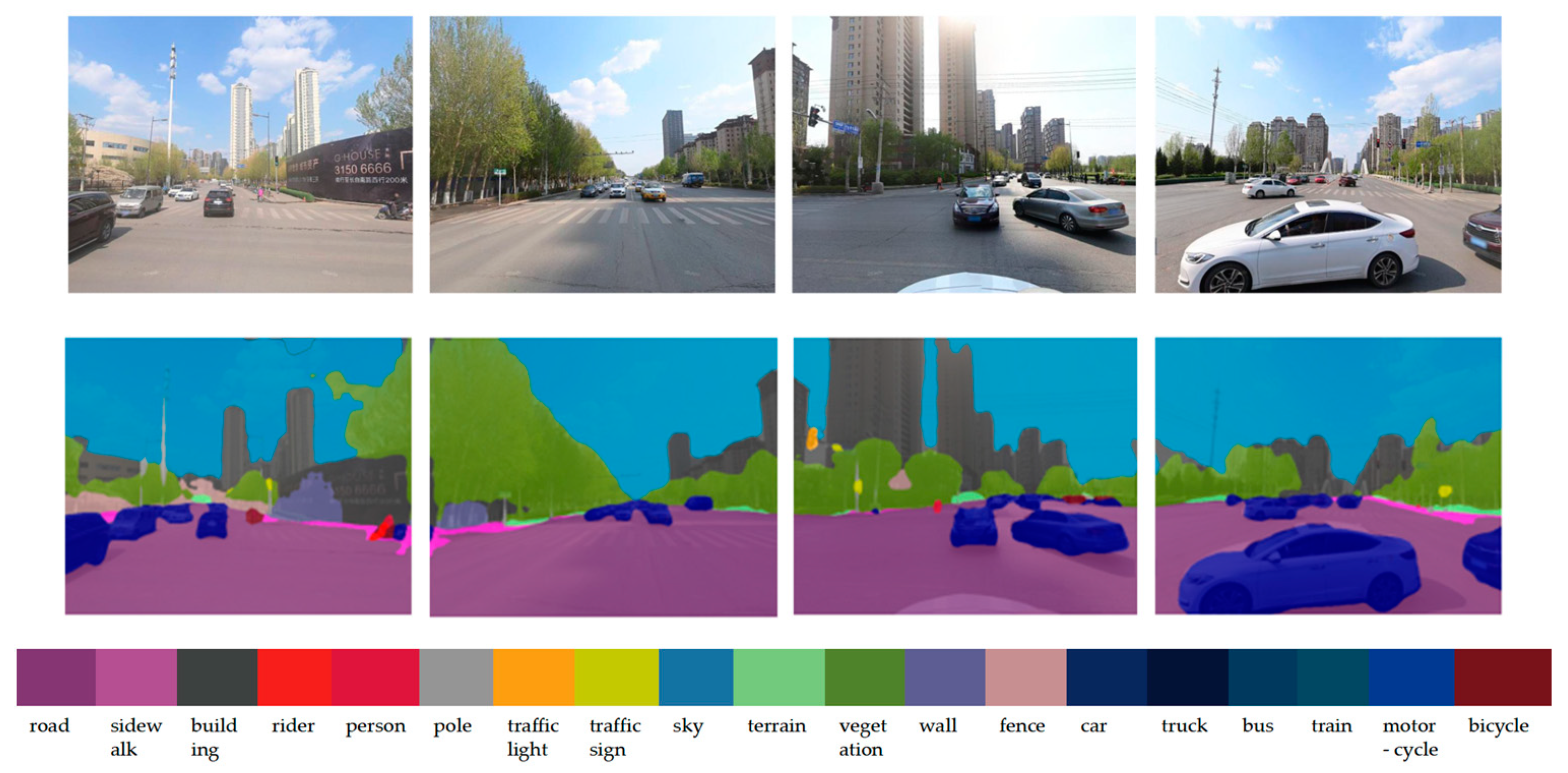
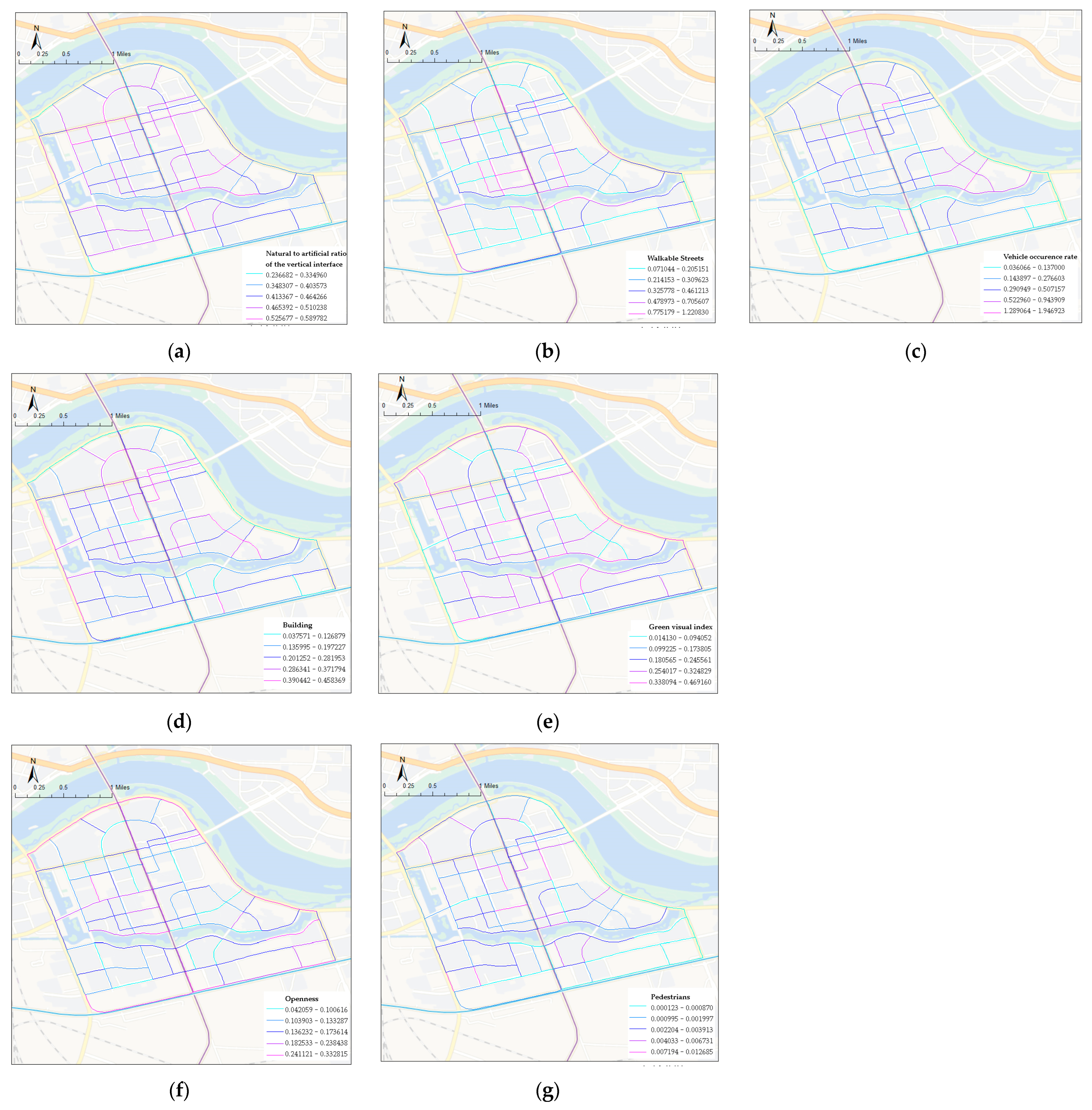
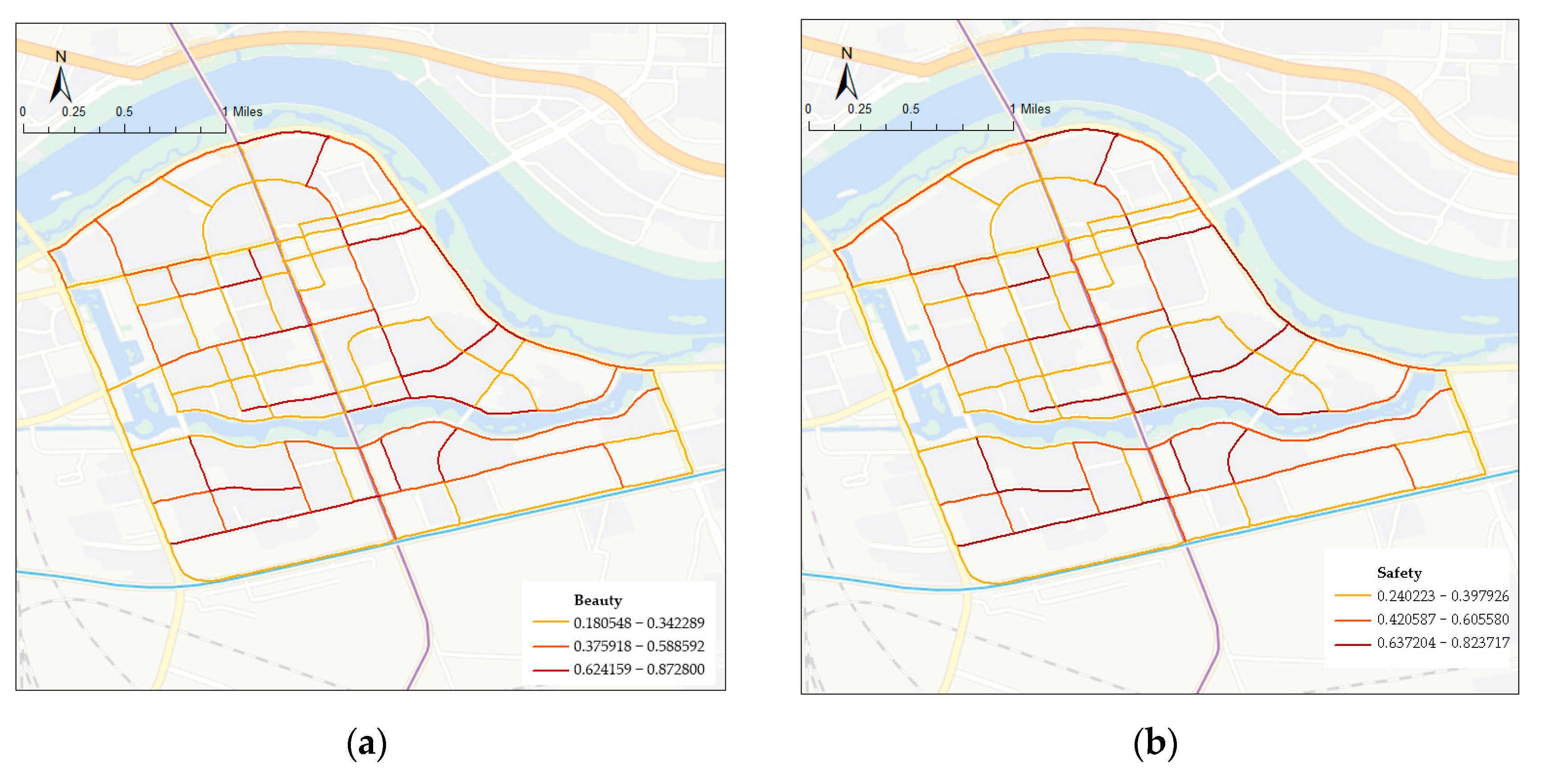
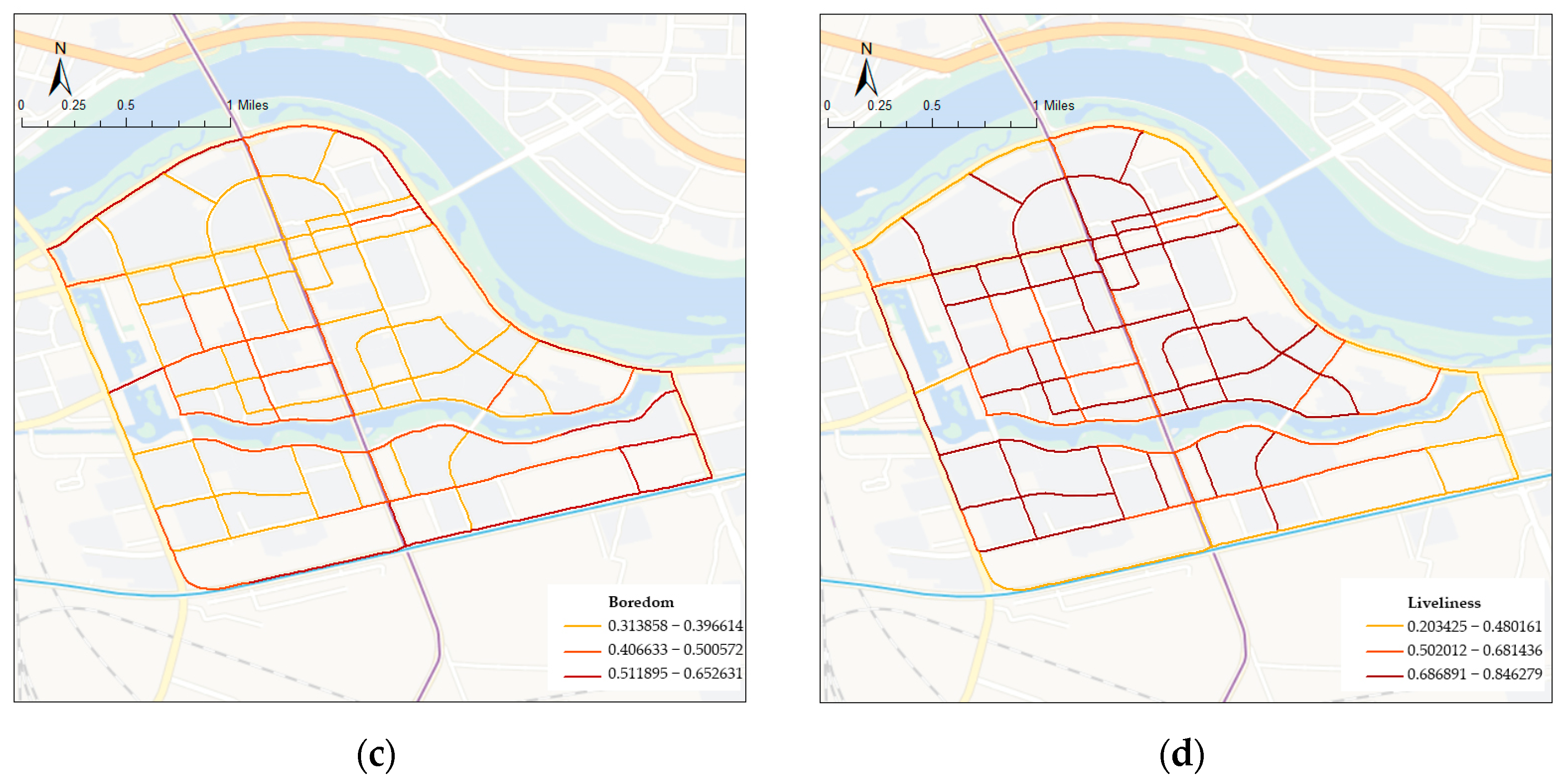
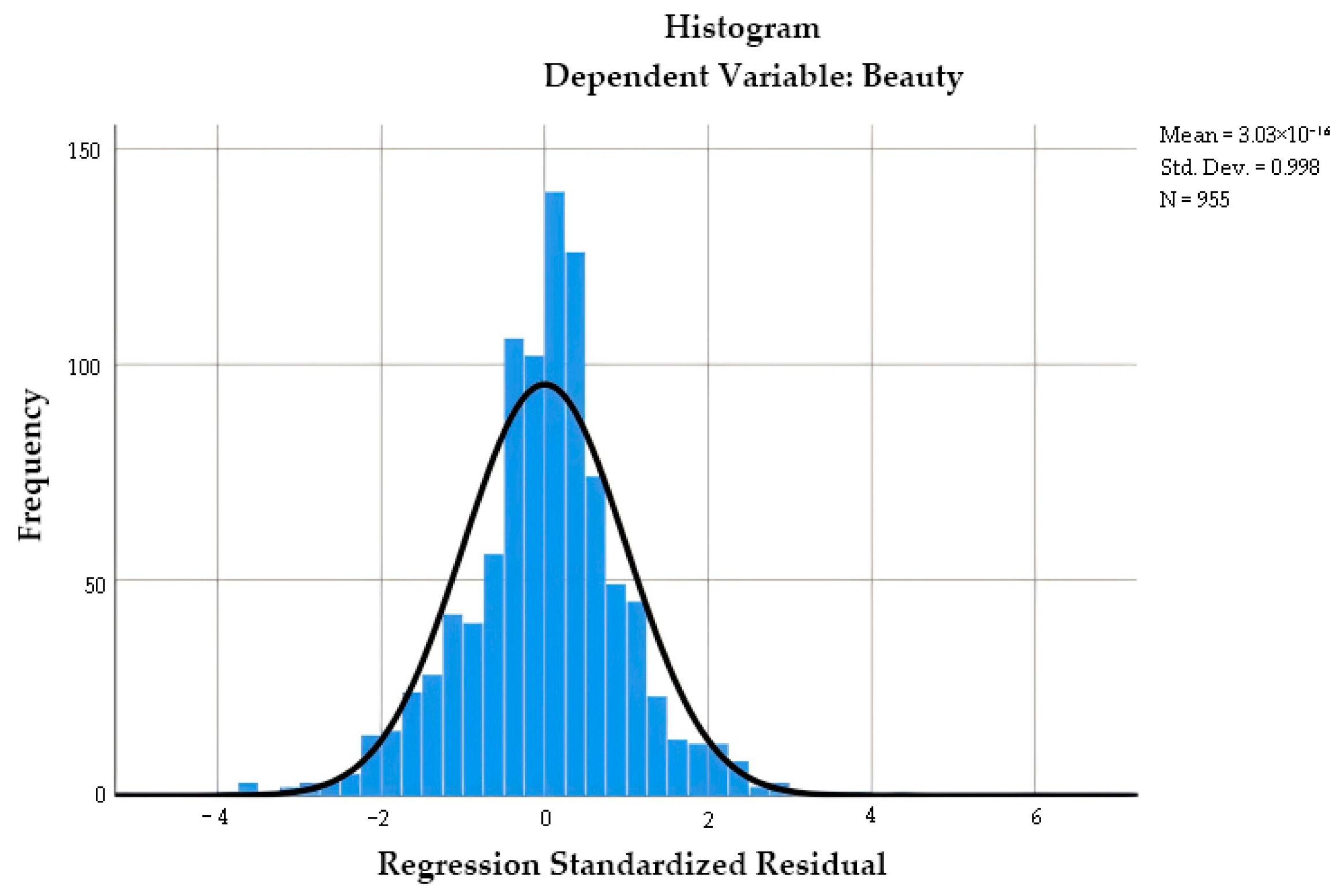
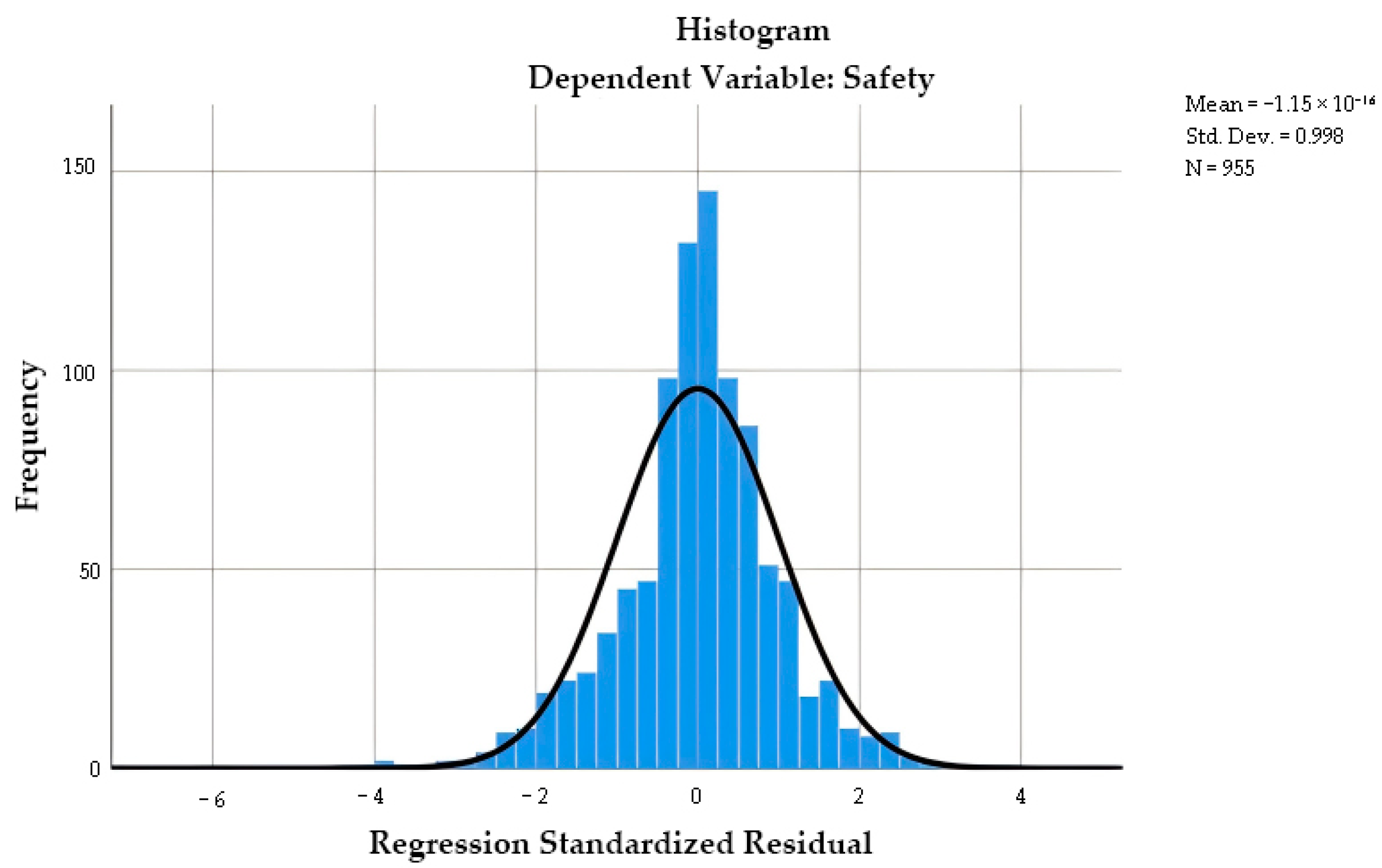
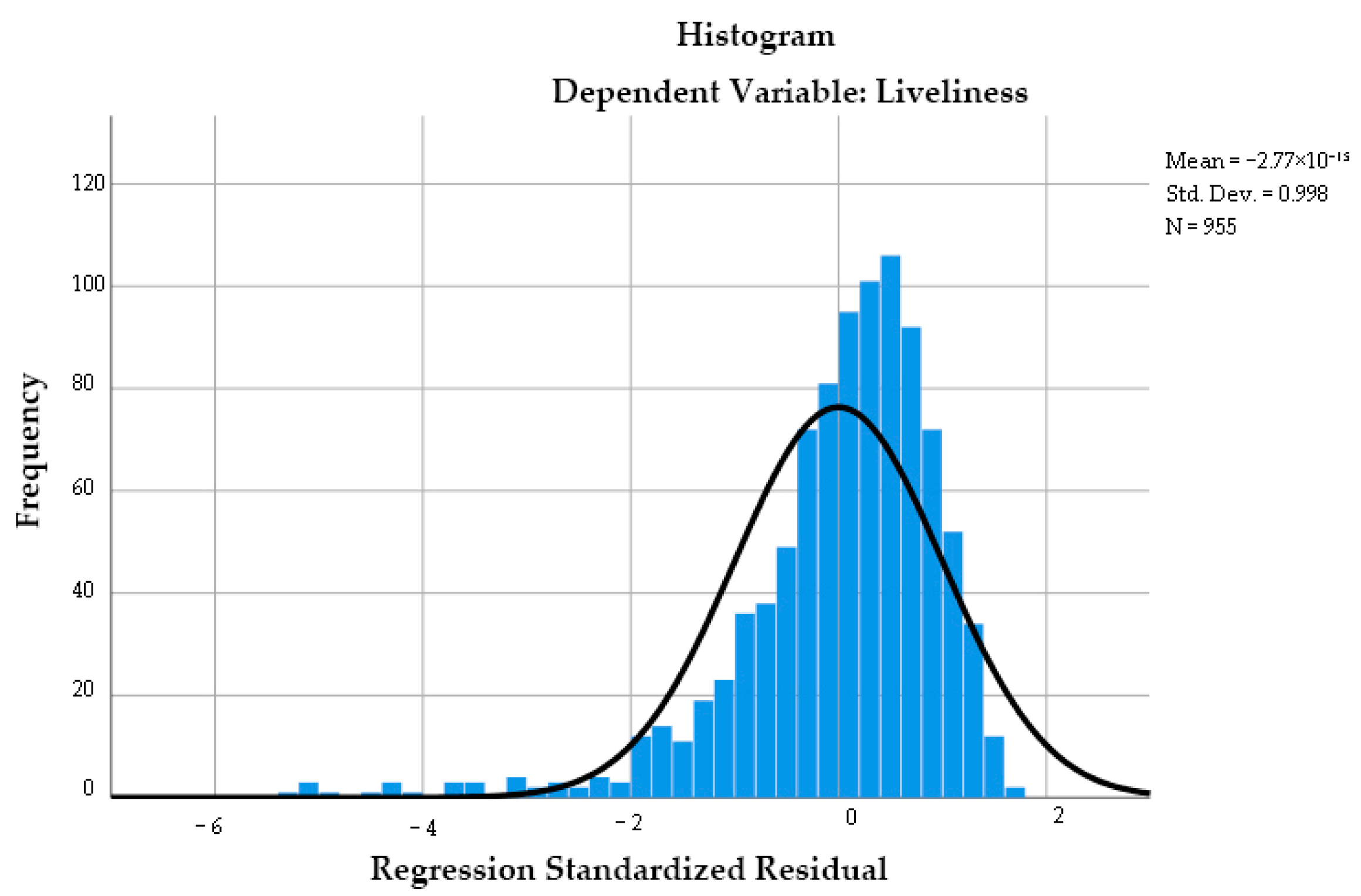

| Street Functional Type | Description | Typical Road Section |
|---|---|---|
| Transportation street | Transportation streets are characterized by continuous closed interfaces. These streets prioritize maximizing motor vehicle movement efficiency, focusing on facilities such as bus lanes. | Example: 2, 7, 22, 38, 70 |
| Residential street | Residential streets serve as composite functional spaces dominated by residential use, where citizens’ daily life and activities are concentrated. These streets constitute linear public space systems anchored by small- and medium-sized commercial services, cultural stations, and public facilities. | Example: 1, 3, 4, 5, 76, 78, 8, 9 |
| Commercial street | Commercial streets are linear public spaces where commercial activities—such as retail, dining, and office uses—predominate, characterized by distinct service capacities or industrial clusters. | Example: 99, 94, 45, 48 |
| Comprehensive street | Comprehensive streets exhibit diverse functions and activities along the roadway, integrating the characteristics of two or more street types (e.g., commercial, lifestyle services, transportation, and landscape–recreation). | Example: 52, 62, 64, 67, 69, 68, 31 |
| Physical Indicators | Formula | Interpretation | Definition |
|---|---|---|---|
| Green visual index | V1i and T1i denote the proportions of vegetation and terrain pixels, respectively. n is the number of BSV images of a sample point. | It refers to the ratio of tree and grass pixels to the overall pixels. | |
| Openness | S1i denotes the proportion of sky pixels; the sum indicates the total number of sky pixels in each image. | It refers to the open degree in the coastal interface. | |
| Walkable streets | P1i denotes the proportion of pavement pixels; F1i denotes the proportion of fence pixels; R1i denotes the proportion of road pixels. | It refers to the ratio of walkable street pixels to the overall pixels. | |
| Vehicle occurrence rate | C1i denotes the proportion of car pixels; T2i denotes the proportion of truck pixels; B1i denotes the pro- portion of bus pixels; T3i denotes the proportion of train pixels; R1i denotes the proportion of road pixels. | It refers to the proportion of vehicle attendance in the road space. | |
| Natural to artificial ratio of the vertical interface | T1i denotes the proportion of tree pixels; B2i denotes the proportion of building pixels. | It refers to the ratio of natural pixels to artificial pixels in the vertical interface. | |
| Pedestrians | P3i denotes the proportion of pedestrian pixels; the sum indicates the total number of pedestrian pixelsin each image. | It refers to the ratio of pedestrian pixels to the overall street space pixels, including riders and standing or sitting pedestrians. | |
| Building enclosure | B2i denotes the proportion of building pixels. | It refers to the ratio of building pixels to the overall pixels. |
| Human Perception | Minimum | Minimum | Mean | Standard Deviation |
|---|---|---|---|---|
| Beauty | 0.181 | 0.873 | 0.411 | 0.201 |
| Boredom | 0.314 | 0.626 | 0.414 | 0.073 |
| Safety | 0.240 | 0.824 | 0.454 | 0.172 |
| Liveliness | 0.253 | 0.846 | 0.661 | 0.140 |
| Human Perception | Residential Streets | Transportation Streets | Commercial Streets | Comprehensive Streets | ||||
|---|---|---|---|---|---|---|---|---|
| Mean | Standard Deviation | Mean | Standard Deviation | Mean | Standard Deviation | Mean | Standard Deviation | |
| Beauty | 0.429 | 0.224 | 0.395 | 0.1845 | 0.389 | 0.2219 | 0.396 | 0.175 |
| Boredom | 0.378 | 0.042 | 0.499 | 0.0842 | 0.359 | 0.026 | 0.431 | 0.063 |
| Safety | 0.470 | 0.195 | 0.424 | 0.151 | 0.443 | 0.181 | 0.450 | 0.150 |
| Liveliness | 0.724 | 0.082 | 0.489 | 0.160 | 0.771 | 0.025 | 0.641 | 0.123 |
| Perceived Features | Beauty | Safety | Liveliness | Boredom |
|---|---|---|---|---|
| 1. Green visual index (GVI) | 0.804 ** | 0.793 ** | 0.024 | −0.042 |
| 2. Vehicle occurrence rate (VOR) | 0.011 | −0.006 | 0.279 ** | −0.326 ** |
| 3. Natural to artificial ratio of the vertical interface (VI) | 0.345 ** | 0.362 ** | 0.701 ** | −0.742 ** |
| 4. Walkable streets (WS) | 0.003 | −0.032 | −0.024 | −0.04 |
| 5. Openness (OP) | −0.285 ** | −0.318 ** | −0.763 ** | 0.783 ** |
| 6. Pedestrians (PR) | 0.007 | 0.013 | 0.180 ** | −0.196 ** |
| 7. Building enclosure (BE) | −0.550 ** | −0.522 ** | 0.498 ** | −0.508 ** |
| Model | Unstandardized Coefficients | Standardized Coefficients | t | Sig. | VIF | Adjusted R Square | F-Sig. | ||
|---|---|---|---|---|---|---|---|---|---|
| B | Std. Error | Beta | |||||||
| 3 | (Constant) | −0.352 | 0.273 | −1.292 | 0.197 | 0.653 | 0.000 | ||
| 1. Green visual index (GVI) | 4.738 | 0.414 | 0.641 | 11.452 | 0 | 8.605 | |||
| 5. Openness (OP) | −2.106 | 0.504 | −0.177 | −4.179 | 0 | 4.946 | |||
| 7. Building enclosure (BE) | −1.281 | 0.471 | −0.16 | −2.718 | 0.007 | 9.504 | |||
| Dependent Variable: Beauty | |||||||||
| Model | Unstandardized Coefficients | Standardized Coefficients | t | Sig. | VIF | Adjusted R Square | F-Sig. | ||
|---|---|---|---|---|---|---|---|---|---|
| B | Std. Error | Beta | |||||||
| 3 | (Constant) | −0.105 | 0.277 | −0.38 | 0.704 | 0.643 | 0.000 | ||
| 1. Green visual index (GVI) | 4.382 | 0.419 | 0.593 | 10.447 | 0 | 8.605 | |||
| 5. Openness (OP) | −2.791 | 0.511 | −0.235 | −5.464 | 0 | 4.946 | |||
| 3. Natural to artificial ratio of the vertical interface (VI) | −1.523 | 0.478 | −0.19 | −3.187 | 0.001 | 9.504 | |||
| Dependent Variable: Safety | |||||||||
| Model | Unstandardized Coefficients | Standardized Coefficients | t | Sig. | VIF | Adjusted R Square | F-Sig. | ||
|---|---|---|---|---|---|---|---|---|---|
| B | Std. Error | Beta | |||||||
| 4 | (Constant) | 0.856 | 0.075 | 11.339 | 0 | 0.628 | 0.000 | ||
| 5. Openness (OP) | −7.805 | 0.261 | −0.657 | −29.944 | 0 | 1.236 | |||
| 7. Building enclosure (BE) | 1.727 | 0.176 | 0.216 | 9.783 | 0 | 1.246 | |||
| 2. Vehicle occurrence rate (VOR) | 0.153 | 0.064 | 0.05 | 2.389 | 0.017 | 1.111 | |||
| 6. Pedestrians (PR) | 10.746 | 5.361 | 0.04 | 2.004 | 0.045 | 1.035 | |||
| Dependent Variable: Liveliness | |||||||||
| Model | Unstandardized Coefficients | Standardized Coefficients | t | Sig. | VIF | Adjusted R Square | F-Sig. | ||
|---|---|---|---|---|---|---|---|---|---|
| B | Std. Error | Beta | |||||||
| 5 | (Constant) | 0.129 | 0.308 | 0.418 | 0.676 | 0.671 | 0.000 | ||
| 5. Openness (OP) | 6.185 | 0.59 | 0.521 | 10.489 | 0 | 7.155 | |||
| 7. Building enclosure (BE) | −1.677 | 0.166 | −0.209 | −10.101 | 0 | 1.247 | |||
| 2. Vehicle occurrence rate (VOR) | −0.3 | 0.06 | −0.097 | −4.968 | 0 | 1.112 | |||
| 3. Natural to artificial ratio of the vertical interface (VI) | −1.553 | 0.479 | −0.157 | −3.241 | 0.001 | 6.811 | |||
| 6. Pedestrians (PR) | −14.225 | 5.042 | −0.053 | −2.821 | 0.005 | 1.035 | |||
| Dependent Variable: Boredom | |||||||||
Disclaimer/Publisher’s Note: The statements, opinions and data contained in all publications are solely those of the individual author(s) and contributor(s) and not of MDPI and/or the editor(s). MDPI and/or the editor(s) disclaim responsibility for any injury to people or property resulting from any ideas, methods, instructions or products referred to in the content. |
© 2025 by the authors. Licensee MDPI, Basel, Switzerland. This article is an open access article distributed under the terms and conditions of the Creative Commons Attribution (CC BY) license (https://creativecommons.org/licenses/by/4.0/).
Share and Cite
Lu, X.; Li, Q.; Ji, X.; Sun, D.; Meng, Y.; Yu, Y.; Lyu, M. Impact of Streetscape Built Environment Characteristics on Human Perceptions Using Street View Imagery and Deep Learning: A Case Study of Changbai Island, Shenyang. Buildings 2025, 15, 1524. https://doi.org/10.3390/buildings15091524
Lu X, Li Q, Ji X, Sun D, Meng Y, Yu Y, Lyu M. Impact of Streetscape Built Environment Characteristics on Human Perceptions Using Street View Imagery and Deep Learning: A Case Study of Changbai Island, Shenyang. Buildings. 2025; 15(9):1524. https://doi.org/10.3390/buildings15091524
Chicago/Turabian StyleLu, Xu, Qingyu Li, Xiang Ji, Dong Sun, Yumeng Meng, Yiqing Yu, and Mei Lyu. 2025. "Impact of Streetscape Built Environment Characteristics on Human Perceptions Using Street View Imagery and Deep Learning: A Case Study of Changbai Island, Shenyang" Buildings 15, no. 9: 1524. https://doi.org/10.3390/buildings15091524
APA StyleLu, X., Li, Q., Ji, X., Sun, D., Meng, Y., Yu, Y., & Lyu, M. (2025). Impact of Streetscape Built Environment Characteristics on Human Perceptions Using Street View Imagery and Deep Learning: A Case Study of Changbai Island, Shenyang. Buildings, 15(9), 1524. https://doi.org/10.3390/buildings15091524






